| Weddings in Japan. Clearly the Japanese have developed special elements in wedding ceremonies which have not been of Western origins, but they have also incorporated a number of features from watching American films, and today many English speaking peoples are performing weddings for Japanese people in buildings that look like churches and in Western attire. An American, whose job in Japan is to perform weddings, told me that he is sometimes asked to perform one hundred marriages in 6 weeks time. With such a busy life he is less likely than I to write a study on the weddings he did perform, or even to wish to keep track of them. Also he probably did not have time to read the Japanese classics or ponder Genji’s wedding.
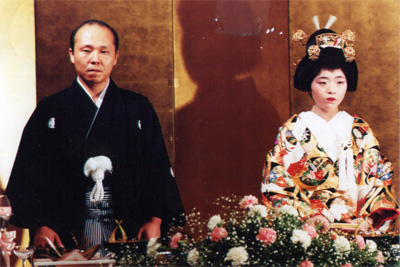
I received the picture above on the back of a post card. Obviously they are wearing traditional wedding costumes, and I also liked the shadow on the gold screen behind them.. The bride knew I was no longer in Japan so she sent the picture. From her formal wedding picture I learned how important it is to Japanese people to send pictures of as a tangible symbol of what is probably the single most important moment in life.
Now for the sake of contrast, I will attach below a more informal photo of the bride above, Nambu Kiyoko, during a walk the year before her marriage, when she was a student trying to better her English. The contrast between the two “faces” she presented to the world in these two photographs is quite clear, for in the picture below she seemed so relaxed and almost ready to break out with a great burst of laugher. I could hardly believe this was the same person in the wedding picture.
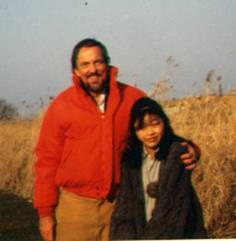
Although I did not managed to get to this wedding, looking at the picture of the two serious young people in elaborate costumes, not very different from scores of other weddings, I could feel their very special energy.
I have been interested in Japanese weddings for twenty years now, and these comments are from events scattered across those years. My first experience in Japan was as an associate dean in the International Division of Waseda University, but in simple language, I was sent by the University of Redlands to assist in the adjustment and advising of students during the l986-87 academic year. I had three students from the University of Redlands, a dozen from USC, and nine from Occidental College.
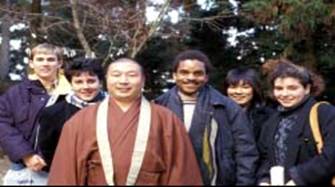
The picture above has one Occidental, two USC and one Pitzer College students, and of course the Buddhist priest. Hiei Mountain is a setting for several monasteries which for a thousand years has been the place of ordination for priests from many different Buddhist sects. The priest told us of a Peace Conference to be held there soon after our visit, and he invited us to come back for it, perhaps knowing that some of us needed a sense of personal peace in our spirits before we could work for world peace. Here are some of students (l. to right) Joe Marenda (who served as a contact person for the updating of these comments), Jane Tiberi, Greg Washington, Kyo Tamura, and Beatrice Pont. What is really interesting about looking at this picture 20 years after the visit to the Hiei Mountain was the number of weddings which happened as a result of our year in Japan.
Greg returned to Japan and married a young Japanese woman who was his host sister. Joe told me of the sad news of Greg Washington's death. Kyo Tamura served as our translator on the mountain that day in l986, she married a Japanese man she met while we were at Waseda and now has three children. Beatrice Pont earned a Ph.D. and works for the European Union, meanwhile marrying a man she met in a bookstore near Waseda. Her husband is also Spanish and they live in Paris. Joe reported going to Yale and studying Classical Japanese for an MA in Japanese Studies (l989). He then did business in Japan from l989 until 1993 and earned an MBA (l995) He is now the CEO of Japanese Tech. Co.
Japanese weddings can involve a variety of different forms. In the highly literate culture of Japan, there are even more magazines which help young people and their family make plans. First, the families would have to decide if they would have a traditional wedding, where even the choice of mates is an arranged marriage or a “love marriage.” I have met several people in Japan who have chosen both forms.
In an arranged marriage, most of the couples move to have a tradition ceremony. Most of the students I taught in Japan told me they would have "love" marriages, but I did meet several people in Japan who had arranged marriages, and they were generally proud of the outcome. For example, Prof. Keiji Takeuchi at Reitaku University once told me he was too busy as a student to find a wife and as a researcher into India, most of his energy and free time was spent in going to India. Moreover, he wanted a wife from his own background and island and asked his family to find his wife.
Why would one otherwise have an arranged marriage? "The custom of arranging marriages began with a parental desire to preserve family lineage and social standing.” Discovering Japan (Nippnia (1999) "Getting Married in Japan,’ p. 60).
How did the families get to this process? A representative of each family does research into family backgrounds of the other family (families) and obtains pictures, which are shared with the families, sometimes with several possibilities being presented.
In such arrangements, the young couple with their families would meet with sharing of food and drinks and give gifts to each other. The groom’s family gives money and symbolic gifts such as dried seaweed which implies a wish for children in the future and abalone which promises long lives for the couple. The brides' family would give something worth about half the value of the gifts from the groom's family. But now engagement rings have replaced the exchanges of money.
Shinto shrines became the setting of weddings for the last century, for the Meiji Emperor was married in a shrine as his ancestors had done for centuries. There the ceremony is dressed in a kimono appropriate for the occasion and the man as well in what looks today like 19th Century costume or in some cases the appropriate attire for the Muromachi period some 500 years ago.
This is the order of a ceremony.
1. A procession while the families come into the shrine, where a Shinto priests offers a purification for all of those present (Shuubatu no gi.)
2. Priests prays for the marriage (Norito sojo) _
3. The nuptial cups holding sake are exchanged three times (San-San-Kuto)
4. Then, rings are exchanged.
5. Next, the vows given by bride and groom (Seishi-sojo). This vow is usually spoken by the groom (or by the male go-between, but now it is encouraged for the groom to do the reading) for it is an important loyalty oath, first to the family of the groom, second to the bride, and third to the family that is created out of the marriage. The bride can speak her vow in return, but both of them sign their names to this part, that is to the vow.
6. An offer is then made to the sacred tree to God (Tamakusi hoten).
A dance by maidens is sometimes made (Urayasu no maihono).
7. The Sake is drunk (Sinszokuhai).
8. After the end the family picture was made. Indeed, the importance of the wedding picture is clear in that one reads: “Gather for wedding picture” at the bottom of the wedding program itself.
(The list came from a 1920’s program at The Grand Tiara Kakasagoden Group), Professor Yash Owada, former Johnston Center Director and former of chair of the Sociology/Anthropology Department make some helpful corrections.
"The Shinto Wedding Text: A Modern Norito”
"We humbly speak before the Majestic and Sovereign Deity,
who is aw inspiring and most highly revered
We imitate the work of the deities who performed this in days of old. Under the auspices of the go between [insert name]
who by grasping the middle of the majestic spear
bids the bride [insert woman’s name] and groom [insert man’s name]
make a wedding vow This day has been designated for ritual.
Due to its auspicious character we celebrate the wedding ceremony
today. It is because the law of marriage is majestically carried out in front of
the great deities
that the proper deportment of ritual must follow.
We make offerings of Sacred food and Sacred Sake;
A variety of tastes are here arranged and set before you.
Eat with delight, listen to the aroma of the offerings, enjoy, and so
accept. The exchange of sake, three times drunk, shared and poured for each
other.
We do that because we are extending our congratulations to each
other.
The vow does not exhaust itself; the cup is never dry. The Vows we articulate are intricately inlaid into our lives in this
world and the next. Growing old together, until our hair is long and white, we have been
caused to be tied.
So does our bond exist in the universe,
just as the sun and moon exist in the heavens
just as the mountains and rivers exist on earth.
Side by side, shoulder to shoulder, putting our home, the ie, in order,
making it settled. Maintain the family gate as a dignified one.
The connection to the ancestors is to be continued and not neglected.
The family name should flourish, be highly respected and widely
known. Our grandchildren and grandchildren should continue forever,
just as the fifty red oak trees,
just as the eight mulberry bushes prosper and propagate. Thus we humbly and most respectfully speak" (Pratt 197-8).
What are the influences upon Japanese people for the weddings which have become so important in their life? (Smith qtd. in van Bremen, 28) concludes “that the Japanese wedding ceremony of today owes less to the traditions of the old warrior class than to a more august inspiration—the wedding of the Crown Prince (Later the Taisho Emperor) in l900, which was the first to be held at a Shinto shrine.
When I asked several Japanese acquaintances if they knew the origins of Taisho-Emperor-to-be was of such an influence.
I wondered what were the ‘religious’ or specifically Shinto aspects in modern ceremonies. I also wondered about the secular reception to be seen in films and television. What were the influences?
I learned that in previous times weddings involved the presentation of the bride to the “ancestors of the household”, which shoed, at least to me, the Confucian background to weddings. Shortly after a wedding, memorial tablets were displayed in a Buddhist alter (butsudan) on the one hand or put on the ancestor shelf (senzodana). In earlier times no priest’s services were needed, because the wedding was a domestic event. Hence, one might judge that only in the 20th Century did weddings become “Shinto” requiring a Shinto priest.
I wondered about the parallels in Western countries, after marriage became a sacrament in Roman Catholic teaching in the Council of Trent was there a wedding in front of a church, with a mass inside, whereby a priest would be needed. Is this an example of Western influences upon Japan if delayed by 500 years in implementation?
I learned that a Buddhist priest could be the official at a Japanese wedding,, but as yet, no one has invited me to such an wedding; yet I happened to be present at the Zane Dojo near Tokyo when the Zen Priest Guido Nishijima welcomed a young Frenchman who wanted to have Nishijima conduct a wedding for him and a Japanese woman. I also found it interesting that the woman did not appear that day; perhaps she came later to determine the outcome. Alas I was back in California by the time the wedding took place, and thereby missed the chance to see a Buddhist wedding in Japan.
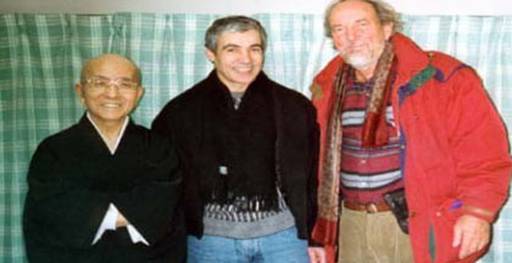
Both the priest and the Frenchman look happier than I do about the prospects ahead for all of us.
In the category of Japanese weddings, I must comment about two weddings that never actually ever happened. Thinking back over my 20 years of study, travel and teaching about Japan, I recall a conversation between two unnamed women in a coffee shop about weddings and marriage. Both women were born in Japan, and both were experienced in the Miai form of introduction to possible husbands in a tradition way. They told of their experiences when in their families contacted a nakado and gave that person pictures and descriptions of the possible-wife-to be. One of the women went a little later to her home and found the handwritten document which her father, a calligrapher, wrote about the family. The document had the following details in beautiful calligraphy:
1. The family name of the father, his birthplace, education, present employment.
2. The wife’s name, maiden name, her birthplace and education.
3. The name of the eldest son, his birth and education and present employment and alongside his wife, age, education
4. The name of the next son, even though he was much younger than some the sisters, same details and of his wife.
5. The name of the husband of the eldest daughter, same details. Then alongside the husband the wife (eldest daughter).
6. So on through the list of several children.
7. Finally, the candidate for marriage, the youngest daughter.
With the same details of birth date, place, education, present employment, with a notation of her hobbies, her achievements, one of which included “typing of English” and her height (not weight).
The opportunity to ponder family values in this document was a memorable moment in what would be “research into memorable weddings,” even though I never was invited to the wedding, because it did not take place in the way the father might have expected, for the woman told me that she was rejected by the young man. But then she told me that she had a second chance, and the father revised the document with a more up- to- date model not unlike the first, except for the placement of the children and a recent listing of employments. This time the young woman rejected the second man; because she said, "I found him talking too much.""
The other woman, who did not show me such a document from her family, laughed for her experience was very much the same as the first.
So far I have discussed marriages which were “arranged” and led to weddings which would have been conducted without an expectation that the bride and groom were “in love.”
As a contrast we shall look at some weddings which did have expectation of the couple having known each other long enough for them to consider “love” as necessary. The Japanese outlook toward many, many things has changed since World War II, and it seems to change more rapidly than in the USA, I offer as a huge generalization from only twenty years of study of Japanese culture. But the expectation of “love” as a component of marriage has been quantified by R. V. Levine in an l993 study where it was demonstrated that less that 5% of “people who would marry without love in various parts of the world” (Rider, 342). In fact fewer people would get married in Japan without love than in the United States. I must confess that I have never conducted a wedding in the last 40 years where love was not evident, nor would, I trust, any of those who wanted to be married have thought it was not important.
Let me offer an example of a “love” marriage in the best sense of a couple who met on a tennis court, asked me to come to their ceremony, and have lived all over the world together, and two years ago had twins, a boy and a girl.
When I left Japan after a year at Waseda, I thought I had lost touch with all the Japanese students. Perhaps through my good karma I met happen to meet Miss Satoko Oki from that class a year later on a train headed for Kashiwa; and she recognized me and said “Are you Huntley-sensei?”
I replied, “Yes, I am he. This year I came back to teach and research Japan some more, but this time I am at Reitaku University.”
She asked me if I would like to meet her fiancée, Jun Sugimoto, whom she had met on the Waseda Tennis Courts (which I recalled was exactly the same kind of setting in which I first met my wife to be Helen in Princeton, New Jersey) She told me that she was graduating from Waseda that year and she was planning a trip to America. Since that meetin she has visited America three times, twice to my home. One time at my home she and her husband slept on futon in a room, which our German shepherd “Chiba” thought was her room. At first the newly married couple became frightened of sleeping so near a dog with such big teeth, perhaps they knew the story of “Red Riding Hood,” but after a few days, all three of them were to be found in the morning sound asleep, as if old friends.
The third trip to the USA was to Hawaii for her wedding. I wish that I could have performed there ceremony, but, alas, I was teaching back in Redlands that semester. Nonetheless, I was able to find a minister for their wedding in Honolulu. I remembered that there was a graduate of the University of Redlands serving as the pastor in the Unitarian Church in Honolulu. Here she, Jun, and the minister are portrayed in Western wedding clothing.
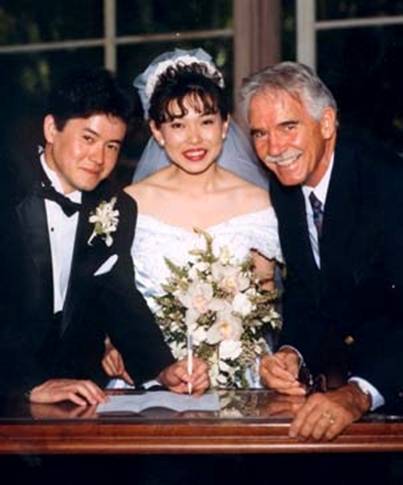
Satoko and Jun’s marriage in Hawaii is an example of the way in which marriages are constantly changing around the world. Their marriage demonstrated to me what has become an increasing pattern in Japanese weddings….namely that they take place in Hawaii. Instead of having difficulty with trying to make up a guest list and buy presents for all who come to the wedding and what is worse, to have to buy or rent traditional or even just Western costumes, the parents of both the bride and groom and a couple of family members fly off to a wonderful vacation in" Paradise" and return all sun tanned and relaxed after a week together.
Although I was not able to go to Hawaii for the wedding, they still sent me a present. Actually weddings are a time when the couple or their families give gifts to all the guests, and when one goes to a wedding one takes money, in 1990 it was" ichi man yen" ($100) but by 2005 I was told to take twice that amount. Below is a photo of the gift I received, dolls representing the bride and groom which are actually scrolls on which the guests write their names. Helen decorated the dolls for an imagined wedding.
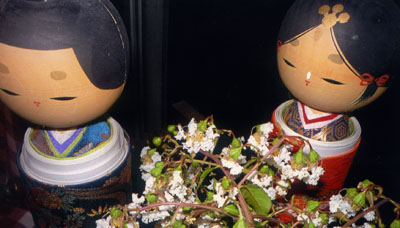
In May of 2006, I was able to visit Jun and Satako, where they were then living in the home of her father and her unmarried sister. Until then, they had lived since l999 in a “mansion” or condo near Kashiwa, and for a time in Bangkok, but when Satoko became pregnant with twins, they returned her the home of her childhood. I wondered about this turn of events.
From Professor Yash Owada(cf. the wedding of his daugher Keiko in "weddings in modern Judaism")I learned about changes that have taken place in the last fifty years, since World War II. Until then, in the marriage of the first son, “the bride married into the grooms’ family. She becomes a member of the groom's family socially and symbolically.” But there was a difference, he added, in the marriage of the younger sons in the family, for in that case," the bride's ties remain strong to her own family, much stronger than her own family than to her husband’s family" (email correspondence from Owada Jan.12, 2007).
Still thinking about Jun moving in with Satoko’s family, I wondered at the time of the wedding if he had made any vows to her family, and was he to be the “Yoshi” or the son adopted into a family with no male heirs, who would be responsible to “create the new family” which in 2006 they had so dramatically done by having twins. Owada commented that to live with Satoko’s father in his house did not mean that his name was necessarily in the family register for their children inheriting the family name of Satoko’s father.
Now for another wedding, which I did not get to attend the wedding pictured below, but I was sent this formal picture to Taka Miyoshi and his bride. The picture is of a couple in formal Japanese wedding attire, and yet it is not a picture of an “arranged” marriage. For I was almost a “matchmaker” because they met on our campus and I went with them on their first date.l
In short, I had hired Taka Miyoshi to be a “language resident” in East Hall, where he promised always to speak Japanese with students who were studying Japanese, and he agreed to hold weekly luncheon meetings with anyone who would sit with him during that meal and speak Japanese. Professor Lawry Finsen, who is featured below in my "album project" (cf. "Weddings of Faculty"), and I were his main “students.” We showed up every week for his tutoring our “intermediate Japanese” through discussion of what we were eating or had done the week before.
Meanwhile during the time he was working at the University of Redlands, Taka met his bride- to- be, a young woman from Japan, who was studying English at a program housed on our campus. Why would I go on their first date? I am not a "matchmaker" he knew that. Instead, I had invited him to a concert in Memorial Chapel, where I had two tickets almost on the front row. During the week before the concert, Taka asked me, "Can I bring a friend whom I have met to the concert?"
I said, "Yes of course!) althought I wondered if either had ever heard Bach before. I gave then the seats on the front row, and I bought myself a cheap seat in the balcony, from which I looked down upon their first date. In Redlands they fell in love. Although they had their wedding in Japan; they celebrated their honeymoon in California.
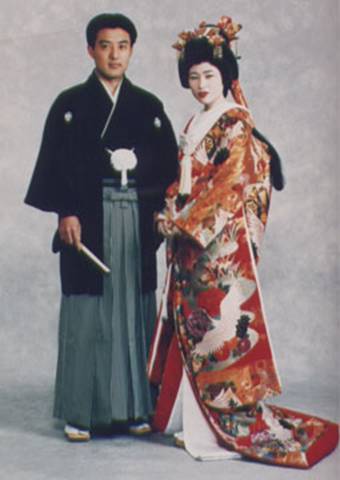
Looking at Taka and his bride, I can imagine the image above was a formal portrait of a wedding from the Meiji Period. The costumes, the posture, the background, the colors, all appear of a portrait from an earlier era. I wonder why they chose to be married in the full wedding costume of Japan. Several times in the passing decade they have returned to Redlands, on their anniversary of the spring that they fell in love here. Taka was soon hired by the NHK (National Television Company) of Japan.
Now let me share a photo of a wedding to which I was never invited, because I did not and still do not know the couple. It is also a confession that I became a “wedding crasher” before I knew the term came into American usage. Below I offer my photo of one of the weddings I crashed:
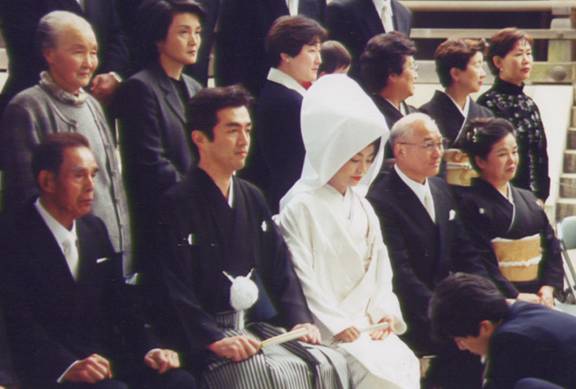
The wedding above was photographed by me at the Meiji Shrine in Tokyo in 2001 during the “Adults Day” celebration. Note that many in the wedding party are looking at the professional photographer (to my right). The bride seems to be looking down. I did not get invited in to the reception thereafter, nor did I actually try to "crash" it, for it was probably in a distant hotel somewhere in Tokyo. . While looking at this picture, I thought I saw a strong resemblance between the groom and his father to his right. What about you, my reader? And where is the "matchmaker"?
Usually the father and mother of the bride are to her left. Am I projecting a sense of genetic connection between the bride and her mother in this picture? Also we must not assume that because it was a Shinto wedding in the most famous Shrine named for the Emperor whose son’s marriage changed Japanese wedding that this was an “arranged marriage”. This couple may very well have met each other at a university or company, fallen in love and expect love will grow for the length of their lives. But I do not know this; I do not know this couple. But I like the feeling expressed in their wedding photograph.
Here below I confess my crashing inclination with another picture taken at the same Meiji Shire in Tokyo, this time of the bride facing away from my camera.
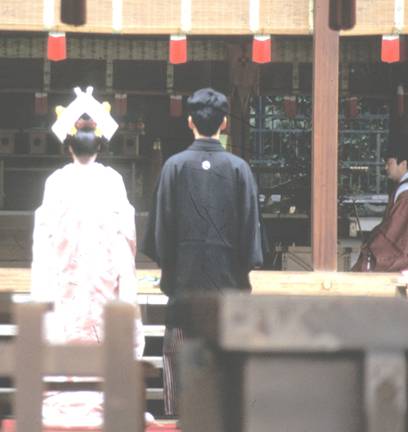
For this photo I zoomed the lens as if I were in the Main Building of the Meiji Shrine, and I even got an image of the Shinto priest who was chanting. Priests do not come out for the group photograph which concludes the ceremony, so this was the deepest intrusion I ever made into a wedding in my crimes of crashing. (See below the "Shinto Wedding Ceremony" in English translation.
Here is my favorite wedding image from Japan which I did not take.
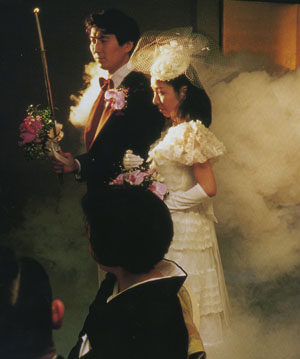
Cohen has captured a wedding with the couple being followed by someone with a "fog making" machine to give a feeling that sometimes one finds in a Western theatre, or did it come from a Kabuki play?
At a Tokyo Station travel agency while on a study trip to Japan, I discovered an option for a Japanese couple who wish to be married. For a small extra fee they can be part of group tour, fly to the USA, and have their wedding in San Francisco, Las Vegas, or maybe even New York; and during one afternoon they have their wedding. If they wish they can join the rest of the group later that day, or perhaps better, the next day can be their honeymoon. After the tour end and they return to Japan, they would, no doubt, have a reception for friends and family there.
From a century ago when almost all marriages were arranged, through the post-war era in “love marriages” when a Shinto wedding ritual might have been used, now many Japanese couples are married in Japan by Americans, who may not even know the Japanese language in which the ritual is conducted, in a little building that looks like a church. The bride may wish to be married in a white dress and the groom in a tuxedo.
In l995 I took a group of students for January to Japan, and because I had been teaching a young man name Takuro Ishizaki, who was enrolled during the fall of 1994 in my first year seminar- “Japan and America”- I had exchanged correspondence with his father, who wrote a brilliant letter to me in English.
I told Takuro, “Your Dad should be a writer.”
Takuro answered, “Oh, he is a writer. He has a pen name, “Yamada Taichi.”
Then I asked Takuro to get something for me that his father wrote. He gave me three books in Japanese and said to me, "My father sent him to America to learn English well enough to become his translator.
By the arrived in Japan that January, I received an invitation from the father to meet him in a Chinese restuarant in the Ginza. . “Yamada Taichi” brought his wife, a daughter, and a “translator.” As the meal progressed I realized that the “translator,” though quite competent was there as more than a translator. As we left the restaurant the “translator” stayed back to talk with me and told me that he had been dating the daughter for two years and never had he been allowed to meet the parents. I was a little shocked. I was also shocked to learn that only because we were invited to dinner, he at last was able to come as translator, but he got to meet Ishizaki-san. He spoke in a tone of “bitter sweetness” when he said, “You Americans can come here and get an invitation, and I have not been allowed ever to meet these parents.”
I responded, “Then you must, thank God we came, for now you got to meet her parents!"
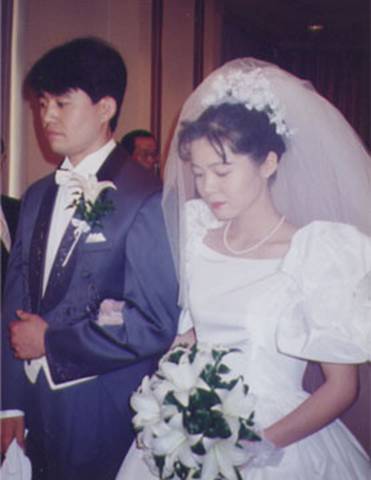
He smiled at my comment, and thereafter things worked out quite well, as the wedding picture they sent me attests. In a letter which came with the picture was a note of thanks, a most appropriate and not entirely Japanese invention as follows:
“Dear Mr. Huntley,
Thank you very much for your telegram (I had sent them a telegram). I should have written to you earlier. The Chinese food’s magic worked very well. We went around Europe (Paris, Venice, Florence, Rome, Mikonos Island (Greece) and Athens. It was a wonderful trip. From Saeko”
The honeymoon travel of this couple seems to have been a bit more extensive than some others I have learned about. But from them I learned not only the success of the “thank you card and picture” of Japanese but of the amazing success of Chinese food and the successful outcome of two years of dating before being asked to be a “translator”. Would one call that patience?
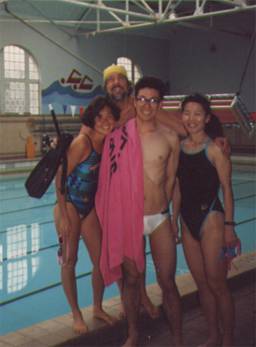
Two other examples of "love-marriages" came to me in pictures (not post cards this time) of two weddings of the sons of Okamura Family, whom I had met in Sun Sports Swimming Pool in Kashiwa in l989. Mariko Okamura was a housewife who taught in a cram school in her home, but she founded a group in Kashiwa, Japan called “the School for Cambodia Committee in l994 and wrote a book in Japanese, as yet untranslate with the title in English meaning roughly “What A volunteer Can Do.” She earned about 10,000 US dollars, and t she used the proceeds gathering about twice that amount from from her 200 member committee to build a school in Cambodia She was awarded a literary prize in honor of a Japanese worker slain in Cambodia. (Asahi Shinbun, l995, June, 19).
The older son, with his bride-to-be (on the left), with his mother (on the right, a former Tri-Athelon competitor in Hawaii. In the picture above we ae at the University of Redlands old swimming pool during a visit to my home in Redlands in what I might call a pre-wedding honeymoon the following year. I must say she told me once that it was “her duty” to see both of her sons married. She certainly achieved her goal.
Visiting our home and the USA the first time, Hiro, the elder son, brought his future bride, who had lived in Brazil for several years with her family who were assigned there by her father’s “trading company.” She had excellent pronunciation of English with only a slight Portuguese accent; moreover, she had mastered a huge English vocabulary from having learned so many Portuguese words whose roots were from Latin. I learned from her how valuable to go abroad as a child
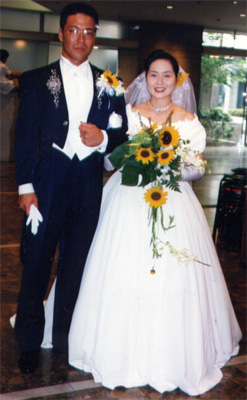
The following year I received the picture of Hiro’s wedding, which I could not attend, but was seen by them as part of the wider international guests who would have been at the wedding had I still lived in Japan. He graduated as a physical education major and selected a career in the field of sports activities. About the same time as Hiro’s marriage his younger brother, Takashi, also had a wedding, which I could not attend, again I was among those who received a picture.
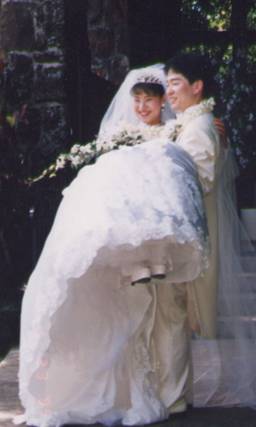
It seems that Takashi had watched many American movies where the groom picks up the bride to carry her over the threshold of their new home. In any case his first job after graduation from college was as an accountant with Arthur Anderson. Okamura-san told me it was her duty to see both her sons married. She did so, sent me pictures, but sadly I recently learned she died of cancer.
At this point in my research into the weddings I was invited to attend and those I “crashed,” I decided to take a spaceship journey far back into the past, to weddings I was born too late to attend. Let’s go back abut one thousand years to Heian Era Kyoto.
“Three Weddings in the Tale of Genji.”
I have long wanted to cruise back a thousand years ago to Heian Period to city of Kyoto and to the palace of the emperor. Even though I am aware that I am looking for fictional weddings to “crash,” I could bring atout severe punishment upon myself.
Nonethe less, I felt brave for I owned translations of The Tale of Genji by Waley, Seidensticker, and MANGA version
So I could recognize all the characters in the weddings of Prince Genji.
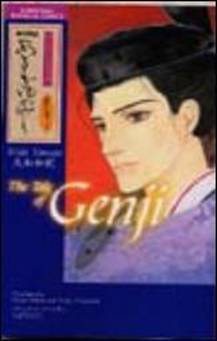
Having taught the "Tale of Genji" by Lady Murasaki about twenty times in the last thirty years, I wanted to attend three weddings.
So I would liked to stay long enough to visit at last three weddings of Prince Genji. He was clearly not as busy as King Solomon of Israel keeping 700 wives and three hundred concubines in what must have been a very big house.
But the Imperial palace grounds preserved as a museum and park in 21st Century Kyoto would easily have housed many women.
Born to a woman who was not the first or highest ranking wife of the imagined Emperor, Genji was so beautiful as a child and into his adult years, many women fell in love with him.
In the time a thousand years ago, a young man, especially of such noble blood as Genji could expect to be married at an early age. So in the first chapter of the Tale of Genji just after he has been declared an adult, age 12 or 13, he experienced the ritual of “Receiving the Hat.” Then his long hair was cut and a hat put on his head.
At that event the betrothal for his first marriage took place, in what we would call an arranged marriage. In Genji's first marriage, the wedding was not described only the betrothal. It took place when the "Minister of the Left", from the elite Fujiwara family, notice the good looks of Genji. He offered his daughter to be married to Genji, whereupon the Emperor, Genji’s father, agreed the wedding would take place. Shortly thereafter, Genji moved to live with his father- in-law and his wife Aoi (named for the plant" Heartvine"). She was 4 years older than Genji and did not like the choice her father had made. But would any 16 year old today like a thirteen year old boy for her mate?
The choice was made by the Minister on the Left and his wife, who was, in fact, “Genji’s aunt and the Emperor’s sister." Genji is about to marry a first cousin”. (Note # 53, Tyler translation, 16). Actually, such a wedding with a cousin was not usual in Heian Japan, at least in the Imperial Court. As in ancient Egypt, power could be retained more easily within family if such marriages took place. Thus in Genji’s first marriage neither he nor his bride had any right to object or even question what had agreed upon by their parents. After some time Genji fathers a baby boy with his first wife Aoi.
The next wedding for Genji, not counting many other brief or long term love affairs, takes place when Prince Genji has matured by a decade. This marriage is a “love marriage.” This wedding was with Murasaki- whose name is now transferred to be also the name of the author of the "Tale of Genji." In this marriae Genji makes the choice of his bride byhimself. Moreover, as in G. B. Shaw’s “Pygmalion,” Genji picked a young woman whom he teaches many things. Perhaps like" Liza Higgins," Murasaki learned more than just how to speak the way her future husband desired. Murasaki grows into maturity, has a wedding, but she never could become the “Primary Wife, ” for her birth was too far below Genji’s. Nonetheless, this marriage will last “until death," they must have made such a promise in the ceremony.
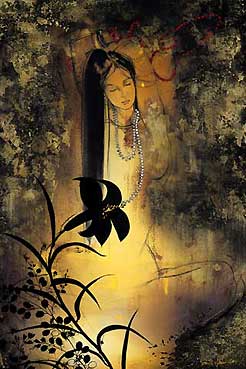
I did not have never thought of Murasaki in such a way (as in the image above) , but finding it on the web gave me new feeling as I typed this paragraph.Genji clearly loved his child-bride Murasaki.
Genji had been drawn to Murasaki because she looked like his step- mother, and he had never known his biological mother. Some students, who are likely to judge characters in novels as immoral by 21st Century standards, sometimes
think of Genji's relationship with Murasaki as “kidnapping." The bride to be is “Murasaki,”the same girl spirited away to Genji's home. This takes place in the 9th month of Genji’s 18th year (not an unreasonable age for a young man to fall for a young woman, but she was perhaps a decade younger than he, so therefore my students feel uneasy.
When he returned, he discovered that she had turned out to be all he could wish, and since he judged that the time had no more or less come, he began to drop suggestive hints’ but she showed no sign of understanding. (Tyler, 186.)
So Genji began his courtship playing the game of Go with her and also a guessing game. One night after watching Murasaki's brilliant mind at work and seeing the gracious lady she had become, Genji wrote a poem for her as follows
"Ah, what distances kept us so strangely apart, what night after night,
we too yet lay side by side in our overlapping clothes."
Receiving the poem, Murasaki realized that she was loved by Genji, and she too was ready now to marry him. A series of gifts were exchanged between them during the next two days. But when a man stayed with a woman for the third night, after which he would wish to marry a woman he gave her rice cakes. That was the promise or the equivalent to a vow in other countries. Genji knew this, Murasaki knew this and Koremitsu, Genji’s “foster brother and confidant” who was asked to bring the cakes. The women including Shonagon, the long time nurse, acted as the witnesses to this wedding with the confirmation of the bringing of rice cakes, even though they seem surprised that Genji decided to make Murasaki his wife.
This wedding took place in the 10th month of Genji’s 22nd year, so he has waited the equivalent of 4 years for her to grow up to “maturity” at age 12 or 13!
In any case, Murasaki is the main love of Genji's life; and throughout the novel she seems an ideal wife to whom Genji is always drawn. Ivan Morris wrote that in Heian Japan the" Primary Wife would have her aims and duties clearly laid down in the Confucian Tradition. She must be an obedient, faithful wife, respectful to her husband and his family and bear him a son, who would maintain the family continuity and perpetuate ancestral cult" (Morris,219).
Murasaki seems to fulfill all the "duties" listed above except bearing Genji a son, which she could not do, but she is brought a daughter, Genji's daughter through another union, and Murasaki serves in the role of mother to her. Remember that it was the first wife, Aoi, discussed above who bore Genji's son.
Norma Fields sums up their love story as follows:
“The story of the young Genji and Murasaki bears a fairy-tale like outline. She is an orphan girl with nothing but herself to offer, he is a handsome prince fallen on hard times. They are faithful to each other and are rewarded for their virtue. It seems to reason that such a relationship would flourish in inverse proportion to external circumstance.” (Fields, 175).
Genji’s third marriage is a curious one. A the time of this marriage, Genji is 39 years old, and his brother, the "New Emperor" Suzaku, is ready to retire. (Chapter 34 “Spring Shoots”). Thus, he requests (or orders) Genji to become the protector of his daughter, who comes of age just at the time the Emperor wishes to retire. Genji realizes that this means he will have to marry the young woman, whom he does not love and who is in fact his niece. Her name ONNA SAN NO MIYA means "Number 3 Princess."She might have been called "Number 3 Wife."
After the marriage, she bears Genji as a son, whom Genji comes to love, but the boy is not really Genji’s legitimate son, for another man, a friend of Genji’s own son 20 years younger than Genji has slipped into "Number 3 Princess' bed" and impregnated her. At the wedding, none of us "guests" could have imagined that such a fate awaited the couple. But it was a formal wedding described mostly in terms of the movement from the bride’s father’s house to Genji’s house which is not on 6th Avenue. Such a movement of a woman from one house to another might have been the only action that comprised a wedding. Words spoken might have been unnecessary.
So, dear reader, were you aware that almost twenty years passed since the wedding with Murasaki and nearly thirty since Genji’s first wedding. Let’s go back to our spaceship and back to the 21st century.
When I climbed out of my "spaceship" and checked email, I found the following message from an exchange student from five years ago, a graduate of Reitaku University who has stayed in touch and who brought me a wonderful present. She knows of my poor handwriting and instead of just complaining the way most folks do, so gave me a package of little wooden blocks with Japanese inscriptions that when stamped on a paper suggest to the student that he must correct a paragraph, do the whole paper over again, or be congratulated on a job well done. Today I received the following:
Hi Bill,
Thank you for giving me (a draft of your comments on Japanese wedding)
(But) I didn't expect to receive an assignment (of reading and correcting your essay).
I am sorry I didn't read the whole thing, but briefly having read your
report, I think it is very interesting because it's full of your personal
stories and experiences, and with many of your own pictures of various
versions of Japanese weddings!
Actually I have worked in wedding industry for a long time, at several
wedding houses and locations.
Here in my hometown I work as an attendant for professional gospel singers
who are mostly African Americans. They live in Japan to work as
professional singers on the stage, but they also perform a short show for
wedding receptions on holidays. We call it "gospel live" and this kind of
entertainment is getting popular among couples who want to have a big
wedding party.
I think wedding receptions were held for the sake of bride and groom's
parents and family in old times, but nowadays I get the impressions that
wedding industry is so couple-oriented and that couples arrange a party for
their friends as their main guests. So, wedding receptions look like a
total leisure to me here in Japan. Very funny, I think.
Well, I wish you lots of luck in your project and I hope it goes well.
And please take great care of yourself, Bill.
….I hope you are doing well and in a good
health and spirit!
Yours truly,
Rieko
Reiko’s comment brings us back into the 21st Century, where we started with the Americans working in Japan, and her job seems to be the result of her having come to America, mastered English with great ability, and now participating in the changes going on in Japanese weddings today.
I have never heard the English version of a Shinto wedding ceremony, but one can now read it.
I spent a year at Reitaku University near Tokyo from 1988-9, and next door to my office was Takeuchi Keiji, a professor who had lived in India for several years. When he returned from his first long trip to India, he asked his family in Shikoku to find a wife for him in what may be a modern form of an "arranged marriage." He was happy to be asked about his wedding one night at his apartment that he got down his wedding picture, and I managed to photograph him showing it to me.
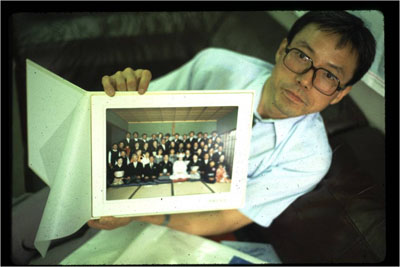
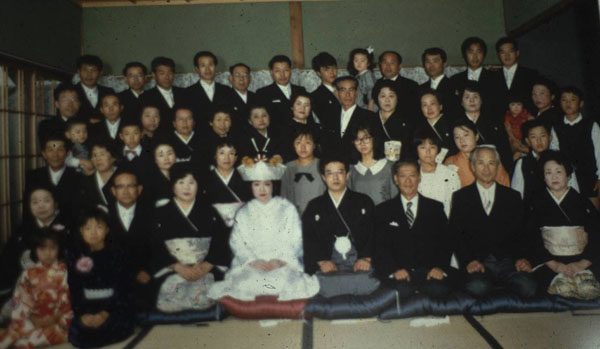
Above in a "close-up" of the same wedding, in which the couple appears in full wedding attire. They were great "homestay parents" in two successive years for Redlands students in the 1990's, meanwhile he continues his interest and scholarship and publication about India, and he gave a lecture to my students in 2005 about India. Was this photo a prediciton of a happy marriage? Or did their wedding photo show the cultivation of a friendship that grew into a love with the support of the parents and matchmaker? (In this photo the "matchmaker" is the gentleman in the blue and white tie next to Takeuchi-san). |